This posting looks at our free BLENDING program; what it teaches, how it works, who it is for, and where it came from. If you just want to get started, then here is a 9-minute quick-start video. Click here for the sign-in screen, which you can bookmark for quick access later.
The free BLENDING program on this website teaches how to sound out words for reading and spelling, focusing first on decoding short-vowel sounds which many struggling readers find particularly tricky. Without mastery of these skills, your student has no hope of becoming a strong reader.
Weakness in these skills is the ‘signature’ of dyslexia, and correcting these weaknesses is the first step to overcoming dyslexia.
Overview
BLENDING is a remedial synthetic phonics program that teaches the mapping between spellings and sounds. The student learns to decode in a systematic, explicit, consistent, and efficient way. The mapping is reversible, both reading and spelling are taught together.
This program was designed for severely dyslexic readers – those who cannot read at all, or read with memorized words and guessing from first-letters and context. These students usually read far below grade level, and their reading is effortful and error-prone with almost no comprehension. This program can also be used for readers who lack automaticity (slow-but-accurate readers) in conjunction with fluency drills.
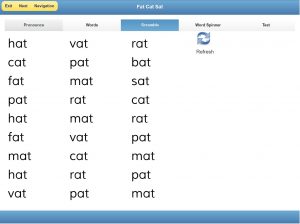
The first of about 150 exercises starts by ensuring that your child knows simple consonant sounds. Usually students find this lesson easy.
BLENDING is a collection of about 150 progressive lessons, each developing, contrasting, or reinforcing a specific spelling-sound mapping. They are not challenging to a skilled reader, but you may be surprised how difficult they are for your child, until each is mastered.
BLENDING focuses on teaching blending skills to automaticity. Almost all our students have sat through years of phonics training, and still can’t read. Although they may know the ‘rules’ of decoding, without automaticity they don’t decode when they read. This program focuses on building automaticity and moving ‘guessers’ into real reading.
The program is designed for use by parents and volunteers, no special training or skills are required other than normal reading and patience. The program is easy to use, embeds pacing and lesson sequencing, and tracks individual progress so that volunteers can ‘share’ students. It is designed for one-on-one tutoring, and is not suitable for group or classroom training.
This program is intended for older students (say 7 and up) and adults. It is intensive and remedial, without drawings of ducklings or videos of flying cows. You and your student are two adults, working together as a team, focused on rapid progress, determined to develop strong reading skills, and looking forward to sharing great books.
BLENDING follows the model of “Direct Instruction” (DI), which refers to a behaviorist style of teaching that allows one and only one interpretation of each lesson, avoiding misunderstandings and confusion, building mastery in small, systematic steps, and confirming mastery through testing, reviews, and practice. Learning is a messy process, but DI methods ensure that this foundation of reading is learned optimially by every student.
BLENDING should be taught in conjunction with reading high-interest books at a grade-3 level such as Goosebumps (we’ll post how to do that in a separate post). When you start with your child, you may be doing all the reading. Over the weeks, your child will gradually take over and start reading to you.
Before You Start

The third lesson contrasts the –t and –p words. Students with weak phonological skills start to find this harder. This image shows Word-Art rendering (the /ah/ sound is spelled ‘a’).
The prerequisite for BLENDING is that your student knows the mappings between simple consonant spellings and sounds, for example that ‘b’ makes the sound /b/ as in ‘bat’ and ‘r’ makes the sound /r/ as in ‘rat’. You might test by calling words from the first lesson exaggerated emphasis (‘b-b-b-bat’) and asking your student to name the letter of the first sound. If your student struggles, then you should start with alphabet card drills.
It may sound absurd to ask an older student if he knows the usual sound of the letter ‘m’, but we have worked with grade-8 kids who lack or have forgotten this knowledge. Don’t be shocked or surprised, just teach them what they need to know.
BLENDING is not the same as reading
There are several foundation skills required for looking at the three letters ‘b-a-t’ and decoding the word ‘bat’. These skills must be ‘over-learned’ to the point where they are fast, effortless, accurate, and automatic. If your child struggles with a severe reading deficit then it is almost certain that he is not automatic, and may even be missing one or more skills.
Imagine you wish to learn tennis. Before you whack your first ball your teacher will make you practice holding the racquet properly, shuffling from side to side, moving to forehand or backhand position, and pulling your racket back smoothly. There is no time to think when the ball is coming at you, these skills must be automatic. If a player struggles, the teacher will pull him off the court and go back to basics.
It is the same for reading. Your child is struggling, and we must ensure he has foundation skills. We must teach in an unambiguous way, allowing no possibility of shortcuts or missed steps. And since we can’t see how your child actually “swings his racket”, we must not make any assumptions.
So BLENDING practice is not the same as reading.
To underline the importance of these drills, consider this: You find them trivially easy and your child struggles with them. We can ask about how and why, but there is nothing wrong with your child. These are merely skills that can be taught and learned, and the pressing task is teach them quickly and move on to real reading.
What does the BLENDING program look like?
BLENDING is a set of progressive lessons that present lists of words without context. A tool called the ‘Word-Spinner’ allows building words interactively. The early lessons look like ‘baby-work’, but you are likely to be surprised at how hard they are for your child.
The first group of lessons focus on the vowel /ah/ as in ‘cat’. The first lesson contains ‘-at’ words like ‘rat’ and ‘sat’. The second lesson contains ‘-ag’ words like ‘rag’ and ‘sag’. The third lesson contrasts ‘-at’ and ‘-ag’ words. The fourth lesson introduces the ending ‘-ap’. Remaining lessons in this group contrast and review the /ah/ drills.

We soon introduce the second vowel /ih/. In the 11th lesson we are contrasting the -at and -it spellings for the vowels /ah/ and /ih/. It is always clear precisely what skill we are teaching or practicing, and we focus on that skill intensively until it is mastered.
The next group of lessons does the same the vowel /ih/ as in ‘pit’, contrasting the ‘-it’, ‘-ip’, and ‘-ig’ endings both with each other and with the ‘-at’, ‘-ap’, and ‘-ag’ endings and with each other. The lessons progress carefully through the five short vowels, contrasting every possible combination.
Then consonant clusters and consonant digraphs are introduced using the same five short vowels, they allows blending of longer words such as ‘black’ and ‘pitch’.
The next group of lessons introduce the five ‘long’ vowels using the ‘e-controlled’ spellings, contrasting them to short vowels (‘tap’ to ‘tape’, ‘hat’ to ‘hate’) and to each other. And finally we introduce other vowel spellings using the framework of synthetic phonics.
Most lessons include ‘Word-Art’ which shows the sounds of the letters as well as its spelling. Word-Art becomes increasingly important when the student moves beyond the initial five short vowels and ambiguity in the spelling-sound mappings starts to appear.
BLENDING presents a minimalist layout optimized for high-frequency practice. There are no cartoons to distract attention, and words are presented in large groups to discourage memorization. The student is pushed to sound out the words because his memory becomes overloaded.
Why does BLENDING use ‘word-lists’ instead of connected text?
The BLENDING program is remedial, focusing on fixing skill deficits and correcting bad habits. We know that word-lists, word-art, and word-spinners without context are not literacy. Yet these constructed lists are powerful tools to isolate and train specific skills.
Our goal is to over-train skills to automaticity, until they are fast, effortless, accurate, and automatic. Our tennis player ‘knows’ to pull back the racket smoothly, our task is to practice him until his arm moves automatically, without thinking.
By using carefully constructed word-lists and word-spinners, we can measure and monitor the student’s learning, letting him practice exactly the skills we want him to learn. Word-lists expose gaps in the student’s understanding, and direct the teacher on what skills need additional focus. They provide intensity, hammering at a specific skill, and allow us to filter out unwanted skills that must be unlearned.
- Reading instead of guessing. By presenting words without context, word-lists force students to read instead of guessing.
- Reading instead of remembering. By overloading recall memory with lists of similar words, students are forced to decode instead of relying on memorized words.

‘Word-Spinners’ let you call out words to spell. Usually only one letter is changed (BAT > BAG > BIG…) and the student pushes one letter for each new word. Word-Spinners teach ‘segmentation’, which is necessary for spelling. This example uses only the two vowels and the three endings which the student has mastered at the 21th lesson.
- Reading accurately. By reading words aloud, students expose gaps and errors in their skills that can be addressed in a systematic way.
- Reading with automaticity. By reading words against a timer, students show if they still require cognitive ‘horsepower’ to read, and have not yet automated that skill.
Your child surely ‘knows’ many of the skills listed in the next section, but they must become automatic.
What are the skills that BLENDING teaches?
It is worthwhile reviewing this list of skills, because of course it is not the program that ‘teaches’ them but the tutor. The lessons will only guide you.
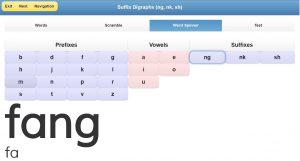
Here is a word-spinner for the endings ‘ng’, ‘nk’, and ‘sh’. The current lesson focuses ONLY on those three endings, and the word-spinner lets you practice them with laser attention.
Sounds of the vowels. Your child may not reliably know the sounds of the short vowels (the vowels in bat, bet, bit, bot, but). If he sounds them wrong, then he may lose the meaning of a text. Many poor readers struggle to pronounce vowels correctly, for example confusing the /uh/ in ‘rug’ and the /eh/ in ‘red’.
Clearly pronouncing vowels. Many students do not clearly enunciate the sounds as they read, they form an approximation that confuses their identification of the word. By making the student read aloud and clearly pronounce from an artificial list, the tutor can monitor for correct pronunciation. The student says the words and hears himself saying them, forming the correct mapping.

Once the five short vowels have been mastered, we add suffix clusters and digraphs, and then prefix clusters and digraphs. Soon the student is blending 4- and 5-letter words, accurately, smoothly, and without guessing..
Looking inside the word. Students develop the habit of looking at the first letter and then guessing. They clearly must see the middle and end letters of a three-letter word, but it doesn’t trigger the reading circuits. Word-lists and the word-spinner provide tools for drilling the skill of considering interior letters.
Blending sounds into a word. Once a student sees the letters and knows the sounds, then the key skill they must master is to sound out the word, to ‘say it fast’ in such a way that they can decode what they read into a word they know.
Segmenting a word into sounds. Spelling requires ‘segmenting’ which is the opposite of blending, breaking of a word into sounds. When you are calling the words and your student is keying them into the word-spinner (or writing them out), then they are practicing segmenting.
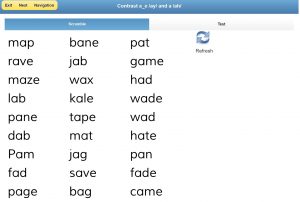
The next lessons teach the e-controlled “long vowels”, introducing and then contrasting them with short vowels and each other. In this lesson the ‘a’ spelling of /ah/ and the ‘a_e’ spellings /ay/ are contrasted and practiced.
Reading words from left to right. When your child is keying the word-spinner and you ask him to change ‘nan’ to ‘nap’ (the word-spinner allows nonsense words), you may be surprised that your child isn’t confident which consonant to change. He knows a ‘p’ is required but must ‘think’ whether it goes in the front or the back. As you drill with reading lists and use the word-spinner, this will disappear.
Every syllable has a vowel. By making the structure of words visible, the student develops a sense of how they might be spelled, and how multi-syllable words might be sounded out.
Chunking consonant blends. After three-letter short vowel words are mastered, BLENDING moves into building automaticity with consonant digraphs and clusters.
What is Synthetic Phonics?
Synthetic phonics teaches the mapping between spellings and sounds (phonemes), and then teaches the blending of sounds to make a word. It is not correct to refer to the mapping between letters and sounds because many spellings have more than one letter (such as the ‘oa’ spelling of /oh/ in ‘boat’).

Older phonics programs focus on initial-sound and word-family, encouraging guessing and developing bad habits.
Older phonics programs taught students to ‘analyze’ a written word into its sounds using rules such as “i before e except after c”, and by guessing from clues such as the first letter and context. Both these approaches have been discredited by reading researchers, unfortunately they are still taught and you will often see ‘word-family’ charts (as on the right) in many classrooms.
It is critical that a student learn to examine, identify, and sound out letters in ALL positions. It is also important to learn that the mapping is reversible, and that the same patterns blended for reading can be segmented for spelling.
Synthetic phonics puts strong focus on clear pronunciation of decoded words. Since there are no ‘phonics rules’, there are minimal exceptions. There is never any guessing in the BLENDING lessons.
One of the tools used is a ‘synthetic alphabet’, a set of symbols representing .each of the 40 or so sounds of English. For example Jolly Phonics uses a ‘snake’ and a slithering hand gesture for the /s/ sound. BLENDING uses a set of common spellings as our synthetic symbols, and Word-Art shows the sound’s symbol above its spelling where they are different.
All reputable Orton-Gillingham programs include some form of synthetic phonics, but they usually teach mappings from the spelling to the sound. We follow the newer, more intuitive practice of teaching from the sound to the spelling.
Where did BLENDING come from?
There is nothing particularly new in BLENDING, it is a remix of two of the most famous phonics programs, broken down into DI steps, adapted for the web and tablets, and made easier for parents and volunteers to use. And of course it is free.
![]()
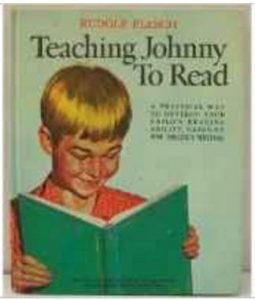 Our inspiration comes from the most famous phonics program of all time, first released in Rudolf Flesch’s landmark book “Why Johnny Can’t Read”, and then re-published in large-format as “Teaching Johnny to Read”. A second-hand copy was selling for $250 recently on Amazon.
Our inspiration comes from the most famous phonics program of all time, first released in Rudolf Flesch’s landmark book “Why Johnny Can’t Read”, and then re-published in large-format as “Teaching Johnny to Read”. A second-hand copy was selling for $250 recently on Amazon.
Flesch argued for early phonics training, even before teaching sight words, to encourage emerging readers to sound out words instead of memorizing them.
His book presents 72 pages of pages progressively harder word lists, each focused on teaching a specific sound or symbol pattern, including two- and three-syllable words.
 We follow his sequence, especially for digraphs and clusters, but with detailed contrasts and reviews. We provide random presentations so that students can’t memorize word-lists.
We follow his sequence, especially for digraphs and clusters, but with detailed contrasts and reviews. We provide random presentations so that students can’t memorize word-lists.
We omit a number of spelling patterns that we now recognize as better taught through morphology. For example ‘tried’ is hard to decode phonetically, it is better decoded as ‘try’ + ‘ed’ with the rule “change the final-y to i before adding a suffix starting with a vowel”. (see our SPELLING module)
But most important, we go much slower than Flesch. BLENDING is a remedial program, designed for fixing a reading deficit. We only present a third of the material in Flesch’s book, even though we have twice as many lessons. For example, Flesch’s very first word-list has all the /ah/ words, we break that page down to eight simpler lessons.
In our opinion, the best synthetic phonics program available is “Reading Reflex: The Foolproof Phono-Graphix Method”. It is sold as a book, the first few chapters explain how to teach your child and the rest of the book has cards to be chopped out. Phono-Graphix was spectacularly effective as the training tool in the Denton (2006) intensive intervention study, helping even students who had shown no progress in other interventions.
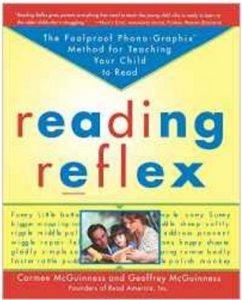 There are two terrific ideas in Phono-Graphix. The first is the use of the most common spelling as the ‘synthetic alphabet’, which is more natural than the gestures or symbols used in other programs (for example the ‘snake’ that makes the /s/ sound in Jolly Phonics). We made the mapping even more explicit in BLENDING with ‘Word-Art’, where we show the sound above the spelling.
There are two terrific ideas in Phono-Graphix. The first is the use of the most common spelling as the ‘synthetic alphabet’, which is more natural than the gestures or symbols used in other programs (for example the ‘snake’ that makes the /s/ sound in Jolly Phonics). We made the mapping even more explicit in BLENDING with ‘Word-Art’, where we show the sound above the spelling.
The other great idea is the card-exercises that Phono-Graphix uses to practice blending and segmenting, which is the heart of their method. But we found that chopping and managing cards was too much work, so we developed the word-spinner to perform the same exercises.
We use the a-i-o-u-e vowel teaching sequence from Phono-Graphix rather than the a-e-i-o-u sequence from Teaching Johnny to Read, since students seem to find increasing difficulty in this sequence. Many other programs also prefer this sequence.
What is Direct Instruction?
‘Direct Instruction’ (DI) is a behaviorist approach for rigorous design of educational materials. DI requires breaking a subject down until each skill is disentangled, arranged into a sensible sequence of small steps, clearly presented with unambiguous examples, and then reviewed and practiced to mastery. It is closely associated with its developer, Sigfried (‘Zig’) Engelmann.
DI puts the responsibility for learning on the curriculum, which must communicate lessons without any possibility of misinterpretation. If the child does not learn, then it is the teaching that is at fault. It is really hard to design a true DI lesson, but once it has been developed then it will work optimally for all students. The research supports DI, but educators revile it. DI is the opposite of the developmental, child-centered, differentiated instruction, and eclectic methods used in our schools.
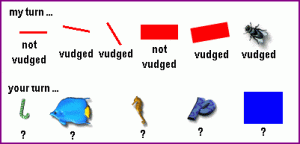 Click here for an excellent tutorial on DI. I have copied their example of teaching the concept ‘vudged’ by isolating its features, showing some examples and non-examples, and then presenting a test. Try it out.
Click here for an excellent tutorial on DI. I have copied their example of teaching the concept ‘vudged’ by isolating its features, showing some examples and non-examples, and then presenting a test. Try it out.
We don’t claim that BLENDING meets the full set of axioms requires for ‘true’ DI, but Engelmann’s writings have informed our design and practice. The careful discipline of DI will be evident when you start teaching your child with BLENDING.




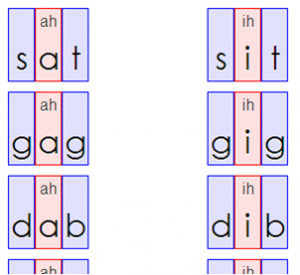

Leave a Reply